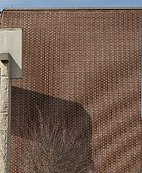
Back استرداف (معالجة الإشارات) Arabic Aliasing BS Aliàsing Catalan Aliasing Czech Aliasering Danish Alias-Effekt German Aliasing Spanish Diskreetmoonutus Estonian الایزینگ Persian Laskostuminen Finnish
In signal processing and related disciplines, aliasing is the overlapping of frequency components resulting from a sample rate below the Nyquist rate. This overlap results in distortion or artifacts when the signal is reconstructed from samples which causes the reconstructed signal to differ from the original continuous signal. Aliasing that occurs in signals sampled in time, for instance in digital audio or the stroboscopic effect, is referred to as temporal aliasing. Aliasing in spatially sampled signals (e.g., moiré patterns in digital images) is referred to as spatial aliasing.
Aliasing is generally avoided by applying low-pass filters or anti-aliasing filters (AAF) to the input signal before sampling and when converting a signal from a higher to a lower sampling rate. Suitable reconstruction filtering should then be used when restoring the sampled signal to the continuous domain or converting a signal from a lower to a higher sampling rate. For spatial anti-aliasing, the types of anti-aliasing include fast approximate anti-aliasing (FXAA), multisample anti-aliasing, and supersampling.
© MMXXIII Rich X Search. We shall prevail. All rights reserved. Rich X Search


